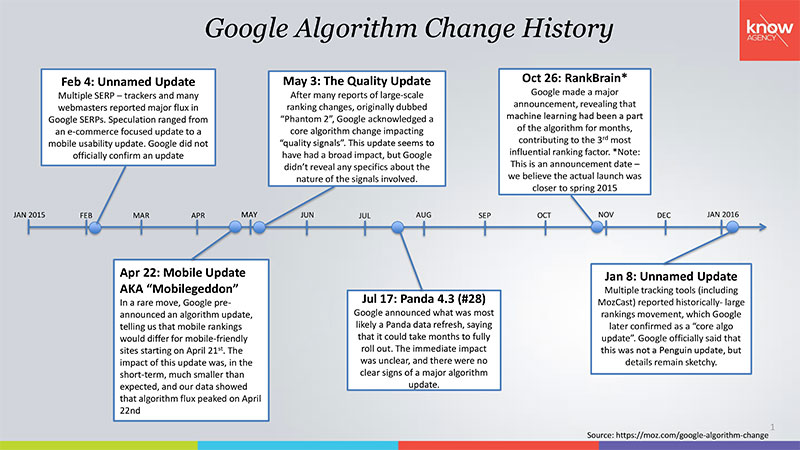As specialists in all things digital and marketing, one of our main priorities is staying up-to-date with Google and how it ranks, scores, and displays search engine results. For the average web user, the algorithm that drives Google search engine results is really of no consequence. But for anyone who is running and marketing a business online, Google search engine results and page rankings are of extreme importance.
You want your website, product, service, or company to be at the top of the results of any Google search. But, how does this happen? Well, this is where we come in – we pay close attention to Google and how it is changing its search algorithm. The search algorithm determines how your website is scored or ranked and this determines where it is displayed on the search engine results page.
To help you understand why you may have noticed changes in how your website has been ranking over the past year, we put together a timeline highlighting the large Google algorithm changes. Of course, this is just a brief overview of the Google updates, if you want to know more about Google and how it really does impact the success of your online presence, the Know Agency team is available to meet with you to show you how these Google updates impact you.
Feb. 4, 2015: Unnamed Update
While this was not an officially confirmed Google update, many webmaster reported a major flux in Google SERPs. There was speculation that this was an e-commerce specific update or perhaps a mobile usability update.
April 22, 2015: Mobile Update AKA “Mobilegeddon”
This was an announced update (rare for Google to announce an update) focused on how the algorithm would rank mobile-friendly sites. Initially, this was predicted to be a wide-reaching update but the short-term impact of this algorithm update was much smaller than expected. According to our in-house data, the algorithm flux peaked on April 22.
May 3, 2015: The Quality Update
An under-the-hood update that had many people reporting large-scale ranking changes, that had a broad impact across users. This update was originally known as “Phantom 2” but Google did eventually acknowledge that it had made a core algorithm change that impacted “quality signals”. To this date, Google has still not revealed any specific details about the signals that were involved in this update.
July 17, 2015: Panda 4.3 (#28)
While this was announced update by Google, the immediate impact of this update is still not obvious. There were no clear indicators of a major algorithm update nor do we know why Google stated that it would take months to roll out this update. In the end, this was most likely a Panda refresh.
Oct. 26, 2015: RankBrain
We learned on this date that Google has been using machine learning as part of its algorithm. This machine ranking had been part of the algorithm for months and contributed to the the third most influential ranking factor in the algorithm. It’s important to note that while this was announced on Oct. 26, we believe the launch was actually much closer to Spring 2015.
January 8, 2016: Unnamed Update
Early in the year, multiple tracking tools (including MozCast) reported historically-high ranking movement. Google later confirmed that this movement was a result of a “core algo update”. While Google has not confirmed that this was not a Penguin update – the details remain unclear about this most recent update.
While we can’t predict what Google will do next with the core algorithm, we can ensure that today your website is ranking on the first page of the Google search engine results. We are professionals who specialize in digital marketing, SEO, social media – ensuring your website and company are at the top of the list.



